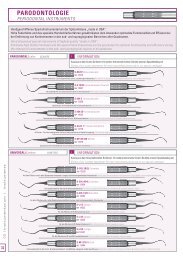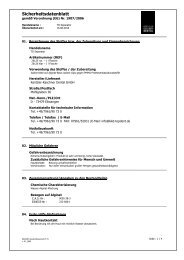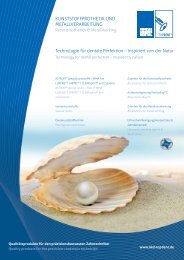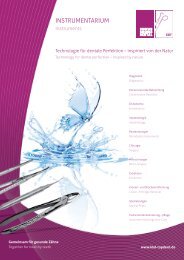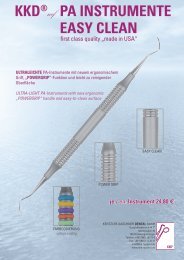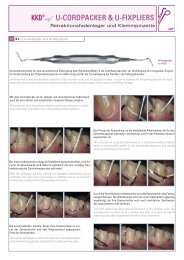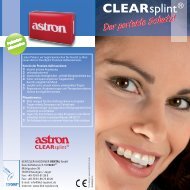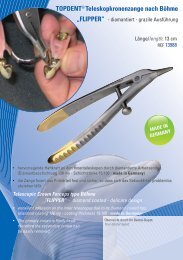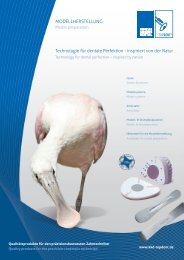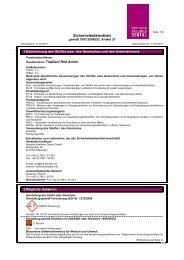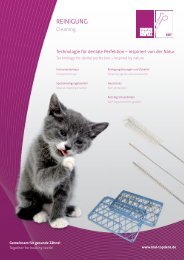Drucktopf Polypot - KENTZLER-KASCHNER DENTAL GmbH
Drucktopf Polypot - KENTZLER-KASCHNER DENTAL GmbH
Drucktopf Polypot - KENTZLER-KASCHNER DENTAL GmbH
You also want an ePaper? Increase the reach of your titles
YUMPU automatically turns print PDFs into web optimized ePapers that Google loves.
01 POLYPOT<br />
POLYPOT<br />
<strong>Drucktopf</strong> zur Polymerisation selbsthärtender Kunststoffe - druckluftunabhängig<br />
Äußerst praktisches, sicheres und mobiles Gerät zur Polymerisation aller bekannten Kaltpolymerisate bis<br />
zu einer Temperatur von max. 50° C.<br />
Handliche Konstruktion, einfache Bedienung. Absolut betriebssicher. TOPDENT ®<br />
<strong>Polypot</strong> wird nicht an<br />
Druckluft angeschlossen und ist netzunabhängig, somit entfällt jegliche Explosionsgefahr. Der Arbeitsdruck<br />
von max. 2 bar wird manuell hergestellt und zwar durch einfaches Zudrehen der Druckspindel, die<br />
über den Deckel Druck auf das Wasser ausübt. Die erforderliche Polymerisationstemperatur wird durch<br />
Einfüllen von entsprechend warmem Wasser erreicht. Der kompakte Kunststoff-Topf hält die Wassertemperatur<br />
ausreichend lange konstant.<br />
TOPDENT ®<br />
<strong>Polypot</strong> ist ideal für den Arbeitsplatz eines jeden Technikers und unentbehrlich im Praxislabor.<br />
Selbsthärtende Kunststoffe erreichen durch die Druckpolymerisation ihre maximale Härte und Dichte;<br />
Porositäten und Farbveränderungen werden vermieden.<br />
TOPDENT ®<br />
<strong>Polypot</strong> ist optimal für Reparaturen, Unterfütterungen, Erweiterungen, provisorische<br />
K&B-Arbeiten, KFO-Apparate u.v.m.<br />
GEBRAUCHSANLEITUNG<br />
1. Arbeitsmodell gründlich wässern, um ein Aufsteigen von Luftblasen zu verhindern.<br />
2. Kunststoff aufbringen und Arbeit in den Topf einlegen.<br />
3. Kontrollieren, ob das Druckablaßventil am Topfdeckel verschlossen ist.<br />
4. Topf bis zum Überlaufen mit entsprechend heißem Wasser füllen, so daß beim Verschließen mit dem<br />
Deckel Wasser über den Rand des Topfes fließt. Dadurch wird jegliche Luft aus dem Topf verdrängt.<br />
5. Den geschlossenen Topf bis zum Anschlag in den Pressbügel einschieben. Durch einfaches Zudre-<br />
hen der Druckspindel den erforderlichen Druck beaufschlagen (maximal 2 bar).<br />
6. Nach der Polymerisation (zeitabhängig vom verwendeten Kunststoff), Druckspindel aufdrehen und<br />
Topf entnehmen. Um den Druckausgleich herzustellen bzw. den <strong>Drucktopf</strong> öffnen zu können, Ablaßventil<br />
aufdrehen (meist genügt schon 1/2 Umdrehung). Druckablaßventil am besten gleich wieder<br />
verschließen.<br />
TECHNISCHE DATEN<br />
Innendurchmesser des Topfes: ca. 100 mm<br />
Nutzraum - Höhe: ca. 65 mm<br />
Gesamtgewicht (leer): ca. 1,3 kg<br />
Erfahrungswerte zur Polymerisation von Kaltpolymerisaten<br />
Wassertemperatur: 50° C<br />
Druckbeaufschlagung: 2 bar<br />
Gemäß § 3 Absatz 2 und 3 der Druckbehälterverordnung wurde der<br />
TOPDENT ®<br />
<strong>Polypot</strong> von einem Sachkundigen einer Abnahmeprüfung<br />
unterzogen und entspricht nach § 3 den allgemein anerkannten Regeln<br />
der Technik, sowie den Arbeitsschutz- und Unfallverhütungsvorschriften.<br />
BITTE BEACHTEN<br />
Pflegehinweis: Druckspindel regelmäßig einfetten.<br />
Topf und Deckel sollten nicht mit Monomer in direkten Kontakt kommen.<br />
REF 23084<br />
<strong>KENTZLER</strong>-<strong>KASCHNER</strong> <strong>DENTAL</strong> <strong>GmbH</strong> · Geschäftsbereich · Mühlgraben 36 · 73479 Ellwangen/Jagst<br />
Telefon: +49-7961 - 91 26-0 · Fax: +49-7961 - 30 89 · info@kkd-topdent.de · www.kkd-topdent.de<br />
¥
PETITE COCOTTE POUR LA POLYMÉRISATION RAPIDE ET HOMOGÈNE DE TOUTES LES RESINES - SANS AIR, NI ÉLECTRICITÉ<br />
� construction pratique et sûre pour la polymérisation de toutes les résines auto-polymérisantes jusqu‘à 50°C (rebasage, bridge provisoire etc.)<br />
Cet appareil se distingue par son maniement très simple, ainsi que par sa sécurite de fonctionnement imbattable. L‘appareil ne doit pas être raccordé à l‘air<br />
comprimé, donc le danger d‘explosion est exclus, parce que la pression de 2 à 3 bar est directement appliquée à l‘eau en visant simplement à la main la vis de<br />
sécurité de l‘étrier. La température de polymérisation est la même que la température de l‘eau que l‘on met dans le pot. Le pot, qui est réalisé d‘une seule pièce<br />
plastique compacte, maintient la température de l‘eau pendant toute la durée de polymérisation<br />
CARACTERISTIQUES TECHNIQUES:<br />
INSTRUCTIONS POUR L`EMPLOI:<br />
Diamètre intérieur du pot:<br />
Hauteur du pot (espace utilisable):<br />
Pression appliquée maxima:<br />
Poids brut:<br />
10 cm<br />
6 cm<br />
2 bar<br />
1,3 kg<br />
F<br />
1. Remplir le pot avec de l‘eau chaude jusqu‘à ce qu‘il soit tout à fait plein. Puis appliquer le couvercle. Ainsi l‘air et l‘eau excédentaires sont éliminés par<br />
l‘écarteur du couvercle. Ne pas laisser d‘air dans le pot.<br />
2. Maintenant pousser le pot avec couvercle dans l‘étrier jusqu‘aux butées et appliquer avec la vis la pression nécéssaire. La pression appliquée maxima est<br />
de 3 bar.<br />
3. Après que le temps de polymérisation soit passé, enlever l‘étrier et pousser prudemment la vis de décharge de pression qui se trouve à la droite du ma<br />
nomètre pour établir une compensation de pression avec l‘extérieur et rendre possible l‘ouverture du couvercle.<br />
POUR LA POLYMÉRISATION: température de l‘eau: 50°C<br />
AVANTAGES:<br />
pression appliquée: 2 bar<br />
Construction simple et indépendante de l‘air comprimé, très approprié pour cabinet avec laboratoire.<br />
Chaque résine d‘usage courant disponible pour compléter des modèles coulés ainsi que pour de réparations ou des rebasages, peut être traité avec cet<br />
appareil. Egalement approprié pour la polymérisation à pression accélérée de matériels de moignons à base d‘éxpoxyde; les temps de polymérisation usuels de<br />
3 à 4 heures sont diminués à 45 à 60 minutes.<br />
PRESSURE CURING UNIT FOR SELF-CURING RESINS – INDEPENDENT OF COMPRESSED AIR AND POWER SUPPLY<br />
� extremely practical, safe and mobile unit for polymerisation of all known self-curing resins up to a temperature of max. 50°C.<br />
Handy construction, easy to work with. Absolutely safe to operate. The working pressure of max. 2 bar is generated manually by just turning the safty screw<br />
downwards giving pressure to the lid and therefore to the water. For curing fill the pot with water of adequate temperature. The pot, made out of compact<br />
synthetic material, will keep the water temperature sufficiently constant during polymerisation.<br />
TopDent <strong>Polypot</strong> is perfect for the working bench of each technician and indispensable in the dentist laboratory. Curing under pressure, all self-curing resins<br />
will reach their maximum hardness and density, the will cure porous free and colour stable.<br />
Use TopDent <strong>Polypot</strong> for optimal repairs, relines, extentions, temporary crown and bridge work, orthodontic appliances etc.<br />
TECHNICAL DATA internal diameter of pot: approx. 100 mm<br />
height of useful space: approx. 65 mm<br />
gross weight: approx. 1,3 kg<br />
HANDLING INSTRUCTIONS<br />
1. Let the model thoroughly soak in water to prevent air bubbles.<br />
GB<br />
2. Apply the resin and place the work into the pot.<br />
3. Make sure that the air removal valve is closed.<br />
4. Fill the pot with adequate hot water until overflowing and close the pot with the lid. A displacer at the bottom of the lid will push away superfluous water.<br />
This overflow avoids air being enclosed into the pot.<br />
5. Insert the closed pressure pot into the pressure frame right back to the stop. Apply the necessary pressure by tightening the screw (maximum pressure<br />
load 2 bar).<br />
6. After curing (time depends on the resin used) open the pressure screw and take the pot out of the pressure frame. To open the pot, equalize the pressure by<br />
turning the release valve (½ turn should be sufficient). Now we recommend to close the air removal valve.<br />
ACCORDING TO EXPERIENCES OF POLYMERISATION<br />
water temperature: 50°C<br />
pressure load: 2 bar<br />
PLEASE NOTE:<br />
Upkeep of the <strong>Polypot</strong>: grease pressure screw regularly. The pot and lid should not get in direct contact with monomer.<br />
APPARECCHIO PER POLIMERIZZARE, A PRESSIONE, RESINE AUTOPOLIMERIZZANTI. NON NECESSITA DI ARIA COMPRESSA.<br />
� E un apparecchio estremamente practico e sicuro per polimerizzare tutte le resine autopolimerizzanti con temperature fino à 50° C.<br />
Maneggevole e facile da usare. Non necessita di aria compresa, non ha componenti elettriche ed è di uso assolutamente sicuro.<br />
CARATTERISTICHE TECNICHE: Diametro interno del recipiente a pressione: 10 cm<br />
Altezza utile del recipiente: 6,5 cm<br />
Pressione massima applicabile: 2 bar<br />
Temperatura massima dell‘acqua: 50° C<br />
Peso lordo: 1,3 kg<br />
ISTRUZIONI PER L‘USO<br />
1. Il modello di lavoro deve essere impregnato in acqua, abbastanza a lungo da evitare che si formino bolle d‘aria quando il modello stresso, ricoperto di resi<br />
na, viene immerso nel POLYPOT.<br />
2. Applicare quindi la resina sul modello armato.<br />
3. Mettere il modello con la resina entro il POLYPOT.<br />
4. Riempire il recipiente con acqua alla temperatura desiderata. Il materiale compatto del recipiente mantiene a luongo la temperatura. Quindi mettere in<br />
posizione il coperchio di chiusura. L‘acqua superflua e tutta l‘aria dovrà essere tolta attraverso la vavola di sfogo<br />
Dal recipiente si deve togliere la sia pur minima quantità di aria, verificare quindi che dalla valvola di sfogo esca acqua.<br />
5. Inserire il recipiente a pressione, con il coperchio in posizione, sotto la staffa sino all‘arresto ed avvitando la vite di regolazione, applicare la pressione<br />
desiderata.<br />
6. Trascorso il tempo necessario per la polimerizzazione, togliere la pressione svitando la vite e premendo con attenzione la valvola di sfogo, posta sulla destra<br />
del manometro. Quando la pressione è scesa a zero il recipiente può essere aperto.<br />
I



